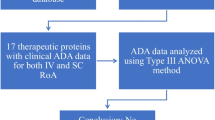Abstract
Background
We carried out a multicenter study to evaluate the safety of recombinant human serum albumin (rHSA), developed using the methylotrophic yeast Pichia pastoris, during and after repeated administration in patients with liver cirrhosis.
Methods
rHSA was administered to 423 cirrhosis patients with ascites or edema. rHSA was administered three times over 3 days, and each 3-day treatment course was repeated at least three times with an interval of at least 2 weeks between courses. Adverse drug reactions (ADRs) were monitored during and after repeated rHSA administration. Specific antibody titers against Pichia yeast components were measured before and after treatment. Efficacy was evaluated on the basis of changes in serum albumin level, colloid osmotic pressure, and body weight.
Results
ADRs were observed in 96 of 423 patients (22.7%), with no serious allergy or difference in the incidence of ADRs observed among the first, second, and third administrations. Specific IgE and IgG antibodies were detected before treatment in 19 and 422 patients, respectively. However, allergic ADRs were observed in 14 patients in whom specific IgE antibodies were not detected. No obvious relationship between allergic ADRs and specific IgE or IgG titers was identified. Serum albumin levels and colloid osmotic pressure increased significantly (P < 0.0001), and body weight decreased significantly (P < 0.0001) after rHSA administration.
Conclusions
rHSA caused no serious allergic reactions even when three treatment courses were administered at intervals of at least 2 weeks.
Similar content being viewed by others
References
Kobayashi K, Kuwae S, Ohya T, Ohda T, Ohyama M, Ohi H, et al. High-level expression of recombinant human serum albumin from the methylotrophic yeast Pichia pastoris with minimal protease production and activation. J Biosci Bioeng 2000;89:55–61.
Ikegaya K, Hirose M, Ohmura T, Nokihara K. Complete determination of disulfide forms of purified recombinant human serum albumin, secreted by the yeast Pichia pastoris. Anal Chem 1997;69:1986–1991.
Ohtani W, Nawa Y, Takeshima K, Kamuro H, Kobayashi K, Ohmura T. Physicochemical and immunochemical properties of recombinant human serum albumin from Pichia pastoris. Anal Biochem 1998;256:56–62.
Sugio S, Kashima A, Mochizuki S, Noda M, Kobayashi K. Crystal structure of human serum albumin at 2.5 Å resolution. Protein Eng 1999;12:439–446.
Kobayashi K, Nakamura N, Sumi A, Ohmura T, Yokoyama K. The development of recombinant human serum albumin. Ther Apher 1998;2:257–262.
Kobayashi K. Summary of recombinant human serum albumin development. Biologicals 2006;34:55–59.
White GC 2nd, Courter S, Bray GL, Lee M, Gomperts ED, The Recombinate Previously Treated Patient Study Group. A multicenter study of recombinant factor VIII (Recombinate) in previously treated patients with hemophilia A. Thromb Haemost 1997;77:660–667.
Lusher J, Abildgaard C, Arkin S, Mannucci PM, Zimmermann R, Schwartz L, et al. Human recombinant DNA-derived antihemophilic factor in the treatment of previously untreated patients with hemophilia A: final report on a hallmark clinical investigation. J Thromb Haemost 2004;2:574–583.
Ewan PW, Coote D. Evaluation of a capsulated hydrophilic carrier polymer (the ImmunoCAP) for measurement of specific IgE antibodies. Allergy 1990;45:22–29.
Tullis JL. Albumin. 2. Guidelines for clinical use. JAMA 1977;237:460–463.
Vermeulen LC Jr, Ratko TA, Erstad BL, Brecher ME, Matuszewski KA. A paradigm for consensus. The University Hospital Consortium guidelines for the use of albumin, nonprotein colloid, and crystalloid solutions. Arch Intern Med 1995;155:373–379.
Ahlstedt S. Understanding the usefulness of specific IgE blood tests in allergy. Clin Exp Allergy 2002;32:11–16.
Soderstrom L, Kober A, Ahlstedt S, de Groot H, Lange CE, Paganelli R, et al. A further evaluation of the clinical use of specific IgE antibody testing in allergic diseases. Allergy 2003;58:921–928.
Author information
Authors and Affiliations
Rights and permissions
About this article
Cite this article
Kasahara, A., Kita, K., Tomita, E. et al. Repeated administration of recombinant human serum albumin caused no serious allergic reactions in patients with liver cirrhosis: a multicenter clinical study. J Gastroenterol 43, 464–472 (2008). https://doi.org/10.1007/s00535-008-2178-5
Received:
Accepted:
Published:
Issue Date:
DOI: https://doi.org/10.1007/s00535-008-2178-5




